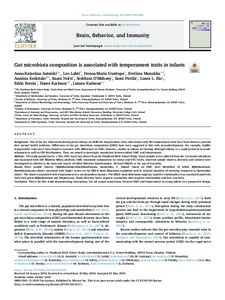Gut microbiota composition is associated with temperament traits in infants
Eveliina Munukka; Anna-Katariina Aatsinki; Laura L. Elo; Siobhain O'Mahony; Sami Pietilä; Henna-Maria Uusitupa; Hasse Karlsson; Leo Lahti; Anniina Keskitalo; Linnea Karlsson; Erkki Eerola; Saara Nolvi
https://urn.fi/URN:NBN:fi-fe2021042826967
Tiivistelmä
Background
One of the key behavioral phenotypes in infancy are different temperament traits, and certain early life temperament traits have been shown to precede later mental health problems. Differences in the gut microbiota composition (GMC) have been suggested to link with neurodevelopment. For example, toddler temperament traits have been found to associate with differences in GMC; however, studies in infants are lacking although infancy is a rapid period of neurodevelopment as well as GM development. Thus, we aimed to investigate association between infant GMC and temperament.
Methods
The study population (n=301, 53% boys) was drawn from the FinnBrain Birth Cohort Study. Stool samples were collected from the 2.5-month-old infants and sequenced with 16S Illumina MiSeq platform. GMC taxonomic composition (at Genus and OTU level), observed sample clusters, diversity and richness were investigated in relation to the maternal reports of Infant Behavior Questionnaire -Revised (IBQ-R) at the age of 6 months.
Results
Three sample clusters (Bifidobacterium/Enterobacteriaceae, Bacteroides, V. Dispar) based on GMC were identified, of which Bifidobacterium/Enterobacteriaceae–cluster presented with higher scores on the IBQ-R main dimension regulation and its subscale duration of orienting compared to Bacteroides-cluster. The clusters associated with temperament in a sex-dependent manner. The IBQ-R main dimension surgency (positive emotionality) was associated positively both with genus Bifidobacterium and Streptococcus. Alpha diversity had a negative association with negative emotionality and fear reactivity.
Conclusion
This is the first study demonstrating associations, but not causal connections, between GMC and temperament in young infants in a prospective design.
Kokoelmat
- Rinnakkaistallenteet [19207]
